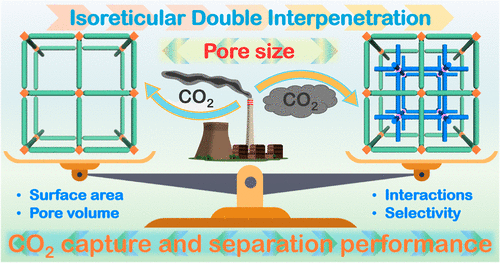
近日,课题组硕士生刘森论文“Efficient CO2 Capture and Separation in MOFs: Effect from Isoreticular Double Interpenetration”被ACS Applied Materials&Interfaces(2023年中科院SCI期刊二区TOP期刊,IF=9.5)接收!
Abstract
Severe CO2 emissions has posed an increasingly alarming threat, motivating the development of efficient CO2 capture materials, one of the key parts of carbon capture, utilization, and storage (CCUS). In this study, a series of metal–organic frameworks (MOFs) named Sc-X (X = S, M, L) were constructed inspired by recorded MOFs, Zn-BPZ-SA and MFU-4l-Li. The corresponding isoreticular double-interpenetrating MOFs (Sc-X-IDI) were subsequently constructed via the introduction of isoreticular double interpenetration. Grand canonical Monte Carlo (GCMC) simulations were adopted at 298 K and 0.1–1.0 bar to comprehensively evaluate the CO2 capture and separation performances in Sc-X and Sc-X-IDI, with gas distribution, isothermal adsorption heat (Qst), and van der Waals (vdW)/Coulomb interactions. It is showed that isoreticular double interpenetration significantly improved the interactions between adsorbed gases and frameworks by precisely modulating pore sizes, particularly observed in Sc-M and Sc-M-IDI. Specifically, the Qst and Coulomb interactions exhibited a substantial increase, rising from 28.38 and 22.19 kJ mol–1 in Sc-M to 43.52 and 38.04 kJ mol–1 in Sc-M-IDI, respectively, at 298 K and 1.0 bar. Besides, the selectivity of CO2 over CH4/N2 was enhanced from 55.36/107.28 in Sc-M to 3308.61/7021.48 in Sc-M-IDI. However, the CO2 capture capacity is significantly influenced by the pore size. Sc-M, with a favorable pore size, exhibits the highest capture capacity of 15.86 mmol g–1 at 298 K and 1.0 bar. This study elucidated the impact of isoreticular double interpenetration on the CO2 capture performance in MOFs.
https://pubs.acs.org/doi/10.1021/acsami.3c16622